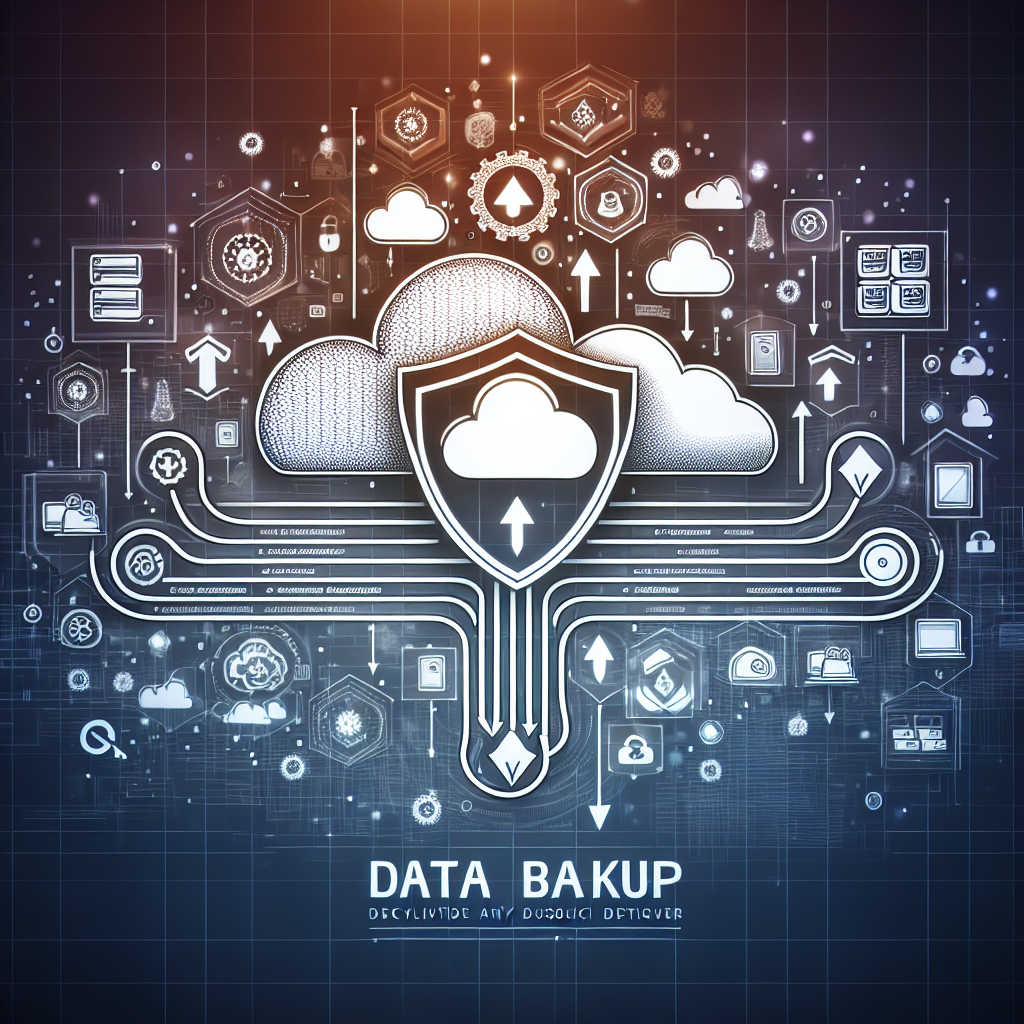Your cart is currently empty!
Tag: Ultimate

The Ultimate Guide to Data Backup and Recovery
In today’s digital age, data backup and recovery have become essential components of any organization’s IT strategy. With the increasing threat of data breaches, ransomware attacks, and natural disasters, the importance of having a robust data backup and recovery plan in place cannot be overstated. In this ultimate guide, we will explore the key concepts and best practices for effectively protecting and recovering your organization’s data.1. Understanding Data Backup:
Data backup is the process of creating copies of your organization’s data and storing them in a secure location. This ensures that in the event of a data loss, you can recover your information quickly and minimize downtime. There are several methods of data backup, including:
– Full backup: This involves making a complete copy of all your data at once.
– Incremental backup: This involves backing up only the data that has changed since the last backup.
– Differential backup: This involves backing up all the data that has changed since the last full backup.
It is important to choose the right backup method based on your organization’s data size, complexity, and recovery time objectives.
2. Implementing Data Recovery:
Data recovery is the process of restoring your organization’s data from backup copies in the event of data loss. There are several factors to consider when implementing data recovery, including:
– Recovery time objective (RTO): This is the maximum amount of time it should take to recover your data after a data loss.
– Recovery point objective (RPO): This is the maximum amount of data that your organization can afford to lose in the event of a data loss.
It is important to establish clear RTO and RPO goals to ensure that your organization can recover its data quickly and efficiently.
3. Best Practices for Data Backup and Recovery:
To effectively protect and recover your organization’s data, it is important to follow best practices, including:
– Regularly backup your data: Make sure to schedule regular backups of your organization’s data to ensure that you have up-to-date copies in the event of a data loss.
– Test your backups: Regularly test your backup copies to ensure that they can be successfully restored in the event of a data loss.
– Secure your backups: Store your backup copies in a secure location, such as an off-site data center or cloud storage, to protect them from physical theft or damage.
– Implement data encryption: Encrypt your backup copies to protect them from unauthorized access in the event of a data breach.
By following these best practices, you can ensure that your organization’s data is effectively protected and recoverable in the event of a data loss.
In conclusion, data backup and recovery are critical components of any organization’s IT strategy. By understanding the key concepts and best practices outlined in this ultimate guide, you can effectively protect and recover your organization’s data in the event of a data loss. Remember, it is always better to be prepared for a data loss than to suffer the consequences of not having a robust backup and recovery plan in place.

The Ultimate Guide to Data Backup and Recovery for Businesses
In today’s digital age, data backup and recovery are essential for businesses of all sizes. Whether you’re a small startup or a large corporation, protecting your data is crucial to maintaining the integrity of your operations and ensuring the continuity of your business. In this ultimate guide, we will explore the importance of data backup and recovery, as well as provide tips and strategies for implementing a solid backup plan.Why Data Backup and Recovery are Important for Businesses
Data is the lifeblood of any business, and losing it can have catastrophic consequences. From financial records and customer information to employee data and intellectual property, the loss of critical data can result in significant financial losses, damage to your reputation, and even legal consequences. That’s why it’s crucial for businesses to have a robust data backup and recovery plan in place.
Data backup involves making copies of your data and storing them in a secure location. This ensures that if your primary data is lost, damaged, or corrupted, you can easily restore it from the backup copies. Data recovery, on the other hand, involves retrieving and restoring your data after it has been lost or compromised. With a solid backup and recovery plan, you can minimize downtime, protect your business from data loss, and ensure the continuity of your operations.
Tips for Implementing a Data Backup and Recovery Plan
1. Identify Your Critical Data: Start by identifying the data that is essential for the operation of your business. This may include financial records, customer information, employee data, and intellectual property. Make a list of all the critical data that you need to backup and prioritize them based on their importance.
2. Choose the Right Backup Solution: There are several options for backing up your data, including on-site and off-site backups, cloud storage, and hybrid solutions. Consider your budget, storage needs, and security requirements when choosing a backup solution. It’s also important to regularly test your backups to ensure that they are working properly.
3. Set Up Regular Backup Schedules: Establish a regular backup schedule to ensure that your data is consistently backed up. Depending on the volume of data and the frequency of changes, you may need to backup your data daily, weekly, or monthly. Automating the backup process can help ensure that your data is consistently backed up without requiring manual intervention.
4. Implement Data Encryption: To protect your data from unauthorized access, it’s important to encrypt your backups. Encryption converts your data into a secure format that can only be accessed with a decryption key. This adds an extra layer of security to your backup and ensures that your data remains confidential.
5. Develop a Data Recovery Plan: In addition to backing up your data, it’s important to have a data recovery plan in place. This plan should outline the steps you need to take to retrieve and restore your data in the event of a data loss. Test your data recovery plan regularly to ensure that it is effective and can be implemented quickly in an emergency.
By following these tips and strategies, you can create a solid data backup and recovery plan that will protect your business from data loss and ensure the continuity of your operations. Remember, data backup and recovery are essential for businesses of all sizes, so don’t wait until it’s too late to implement a backup plan. Start protecting your data today and safeguard the future of your business.

Managed Service Providers: The Ultimate Guide to Outsourcing IT Support
In today’s fast-paced business world, technology plays a crucial role in ensuring smooth operations and staying ahead of the competition. However, managing and maintaining IT infrastructure can be a daunting task for many businesses, especially small and medium-sized enterprises (SMEs) with limited resources and expertise.This is where Managed Service Providers (MSPs) come in. MSPs are third-party companies that offer a range of IT services, including network monitoring, security, data backup, cloud computing, and help desk support. By outsourcing their IT support to an MSP, businesses can focus on their core operations while leaving the technical aspects to the experts.
There are several key benefits to outsourcing IT support to an MSP. First and foremost, MSPs provide businesses with access to a team of highly skilled IT professionals with expertise in various technologies. This means businesses can benefit from the latest innovations and best practices without having to invest in expensive training or hiring additional staff.
MSPs also offer proactive monitoring and maintenance of IT systems, which helps prevent potential issues before they escalate into major problems. This can significantly reduce downtime and minimize disruptions to business operations, ultimately saving time and money.
In addition, MSPs typically offer scalable services that can be tailored to meet the specific needs and budget of each business. This flexibility allows businesses to pay only for the services they need, without the overhead costs associated with managing an in-house IT department.
When choosing an MSP, it is important to consider their track record, experience, and reputation in the industry. Businesses should also assess the range of services offered, pricing structure, and level of customer support provided by the MSP.
Overall, outsourcing IT support to an MSP can help businesses streamline their operations, improve productivity, and enhance their competitive edge in the market. By leveraging the expertise and resources of an MSP, businesses can focus on their core objectives and achieve greater success in today’s digital age.

The Ultimate Guide to Data Backup and Recovery Techniques
In today’s digital age, data is one of the most valuable assets for individuals and businesses alike. From important documents and photos to sensitive financial information, losing data can be a nightmare. That’s why having a reliable data backup and recovery plan in place is crucial to protect against potential data loss.Data backup is the process of creating copies of data files and storing them in a secure location to prevent loss due to accidental deletion, hardware failure, or cyber-attacks. Data recovery, on the other hand, involves retrieving and restoring lost data from backups in the event of data loss.
There are several data backup and recovery techniques that individuals and businesses can utilize to safeguard their data:
1. Regular backups: Regularly backing up data is the foundation of any data protection strategy. This can be done manually by copying files to an external hard drive or using automated backup software to schedule backups at regular intervals.
2. Cloud storage: Cloud storage services like Google Drive, Dropbox, and iCloud offer convenient and secure ways to backup data online. By storing data in the cloud, users can access their files from any device and rest assured that their data is safe and easily recoverable.
3. External hard drives: External hard drives are a cost-effective and reliable backup solution for storing large amounts of data. Users can connect the hard drive to their computer and copy files manually or use backup software to automate the process.
4. Network-attached storage (NAS): NAS devices are a centralized storage solution that allows multiple users to access and backup data on a local network. They provide an extra layer of protection by storing data on multiple hard drives in a RAID configuration for redundancy.
5. Disaster recovery plans: In addition to data backup, businesses should have a comprehensive disaster recovery plan in place to minimize downtime and data loss in the event of a disaster. This may include offsite backups, data replication, and failover systems to ensure business continuity.
6. Data encryption: Encrypting data before backing it up adds an extra layer of security to protect sensitive information from unauthorized access. This is especially important for businesses that handle confidential customer data and need to comply with data protection regulations.
7. Testing backups: It’s essential to regularly test backups to ensure that data can be successfully restored in the event of data loss. This includes verifying the integrity of backup files, testing recovery procedures, and conducting regular drills to ensure readiness.
By implementing these data backup and recovery techniques, individuals and businesses can protect their valuable data and minimize the risk of data loss. Whether it’s through regular backups, cloud storage, or disaster recovery planning, having a robust data protection strategy in place is essential in today’s digital world.

The Ultimate Guide to Outsourcing IT: How Managed Service Providers Can Help Your Business Grow
Outsourcing IT services is becoming increasingly popular among businesses looking to streamline their operations and focus on their core competencies. Managed service providers (MSPs) are a key player in this trend, offering a wide range of IT services to help businesses grow and succeed in today’s competitive market.What is outsourcing IT?
Outsourcing IT involves hiring an external company, such as an MSP, to manage and support your IT infrastructure and services. This can include everything from network management and security to cloud computing and data backup. By outsourcing these tasks to a specialized provider, businesses can reduce costs, improve efficiency, and access high-level expertise that may not be available in-house.
How can MSPs help your business grow?
MSPs offer a variety of services that can benefit businesses of all sizes and industries. Here are some ways that MSPs can help your business grow:
1. Improved efficiency: MSPs can help streamline your IT operations, allowing your employees to focus on their core responsibilities. This can lead to increased productivity and faster problem resolution.
2. Cost savings: Outsourcing IT services can be more cost-effective than hiring and training in-house staff. MSPs often offer flexible pricing models, allowing you to pay only for the services you need.
3. Enhanced security: MSPs can help protect your business from cyber threats and data breaches by implementing robust security measures and monitoring your systems for potential risks.
4. Scalability: As your business grows, your IT needs will also evolve. MSPs can easily scale their services to accommodate your changing requirements, ensuring that your IT infrastructure can support your growth.
5. Access to expertise: MSPs employ highly skilled IT professionals who have experience working with a wide range of technologies and industries. This expertise can help your business stay ahead of the curve and adapt to new technologies and trends.
Choosing the right MSP
When selecting an MSP for your business, it’s important to consider their experience, reputation, and the range of services they offer. Look for a provider that understands your industry and can tailor their services to meet your specific needs. It’s also important to establish clear communication channels and service level agreements to ensure that your IT needs are met consistently.
In conclusion, outsourcing IT services to a managed service provider can help your business grow by improving efficiency, reducing costs, enhancing security, and providing access to expertise. By partnering with the right MSP, you can focus on what you do best while leaving your IT needs in capable hands.

The Ultimate Data Backup and Recovery Checklist for Businesses
In today’s digital age, data backup and recovery is essential for businesses of all sizes. Whether you’re a small startup or a large corporation, having a comprehensive data backup and recovery plan in place can save you from potential disasters such as data loss, cyber-attacks, and system failures. To help ensure that your business is prepared for any data-related emergencies, here is the ultimate data backup and recovery checklist for businesses:1. Identify and classify your data: The first step in creating a data backup and recovery plan is to identify and classify the data that your business relies on. This includes customer information, financial records, employee data, and any other critical information. By categorizing your data based on importance and sensitivity, you can prioritize your backup and recovery efforts.
2. Choose the right backup solution: There are several options for data backup, including cloud-based solutions, external hard drives, and tape backups. You should choose a backup solution that meets your business’s needs in terms of storage capacity, accessibility, and security. Consider using a combination of backup methods to ensure redundancy and data protection.
3. Establish backup schedules: Regular backups are essential to ensure that your data is always up-to-date and accessible. Create a backup schedule that aligns with your business’s workflow and data volume. Consider daily, weekly, or monthly backups depending on the frequency of data changes and the criticality of the information.
4. Test your backups: Simply creating backups is not enough – you must also regularly test them to ensure that the data can be successfully recovered in case of an emergency. Conduct periodic recovery tests to verify the integrity and reliability of your backup files.
5. Secure your backups: Data security is paramount in the digital age, especially when it comes to backup files. Encrypt your backup data to protect it from unauthorized access and use strong passwords to secure your backup storage devices. Additionally, consider implementing multi-factor authentication for added security.
6. Implement a disaster recovery plan: In addition to data backup, it is essential to have a disaster recovery plan in place to mitigate the impact of potential data loss events. Identify potential threats to your data, such as cyber-attacks, natural disasters, and human errors, and develop a plan to quickly recover and restore your data in case of an emergency.
7. Train your employees: Data backup and recovery is a team effort, so it’s important to educate your employees on the importance of data protection and the procedures for data backup and recovery. Provide training sessions on data security best practices and ensure that your employees are aware of their roles and responsibilities in the event of a data loss incident.
By following this ultimate data backup and recovery checklist, your business can mitigate the risks of data loss and ensure that your critical information is always secure and accessible. Remember that data backup and recovery is an ongoing process, so regularly review and update your backup plan to stay ahead of potential threats and disasters.

Protecting Your Business: The Ultimate Guide to Data Backup and Recovery
In today’s digital world, data is the lifeblood of any business. From customer information to financial records, data is crucial for the day-to-day operations of any organization. However, with the rise of cyber attacks and natural disasters, protecting this valuable information has become more important than ever. That’s where data backup and recovery come into play.Data backup and recovery is the process of creating copies of your data and storing them in a secure location, so that in the event of a data loss, you can easily restore your information. This process is crucial for businesses of all sizes, as data loss can have serious consequences, including financial loss, damage to reputation, and even legal implications.
So, how can you ensure that your business is properly protected? Here is the ultimate guide to data backup and recovery:
1. Identify your data: The first step in creating a data backup and recovery plan is to identify what data is critical to your business. This includes customer information, financial records, intellectual property, and any other data that is essential for your operations.
2. Choose the right backup solution: There are several backup solutions available, including onsite backups, offsite backups, and cloud backups. Each has its own advantages and disadvantages, so it’s important to choose the solution that best fits your business needs.
3. Set up a backup schedule: Once you have chosen a backup solution, it’s important to set up a regular backup schedule. This will ensure that your data is constantly being backed up and that you can easily recover it in the event of a data loss.
4. Test your backups: It’s not enough to simply create backups – you also need to regularly test them to ensure that they are working properly. This will help you identify any issues before they become a problem and ensure that your data is safe and secure.
5. Create a recovery plan: In addition to backing up your data, it’s important to create a recovery plan that outlines the steps you need to take in the event of a data loss. This plan should include who is responsible for recovering the data, how long it will take, and what steps need to be taken to ensure that your business can continue to operate.
By following these steps, you can ensure that your business is properly protected against data loss. Remember, data backup and recovery is not a one-time process – it requires regular maintenance and testing to ensure that your information is safe and secure. With the right plan in place, you can rest easy knowing that your business is protected against any potential data loss.

The Ultimate Guide to Data Backup and Recovery: Everything You Need to Know
Data backup and recovery are essential components of any organization’s IT strategy. In today’s digital age, data is the lifeblood of businesses, and losing it can have catastrophic consequences. From financial records and customer information to intellectual property and employee data, the loss of critical data can result in financial loss, reputation damage, and even legal implications.To avoid such disasters, organizations must have a robust data backup and recovery plan in place. In this ultimate guide, we will cover everything you need to know about data backup and recovery, including best practices, tools, and strategies to ensure the safety and security of your data.
1. Understand the Importance of Data Backup and Recovery
Data backup involves making copies of your data and storing them in a secure location to prevent loss in the event of a disaster. Data recovery, on the other hand, involves restoring lost or corrupted data from backups.
Data backup and recovery are crucial for several reasons:
– Protection against data loss: Whether due to hardware failure, human error, cyberattacks, or natural disasters, data loss can happen at any time. Having backups ensures that you can quickly recover your data and minimize downtime.
– Compliance requirements: Many industries have strict data retention and backup requirements to meet regulatory compliance. Failure to comply can result in fines and legal consequences.
– Business continuity: A robust backup and recovery plan is essential for maintaining business operations in the face of disruptions. It ensures that critical data is accessible when needed.
2. Implement a Data Backup Strategy
To create an effective data backup strategy, consider the following best practices:
– Identify critical data: Determine which data is essential for your business operations and prioritize backup accordingly.
– Choose the right backup solution: There are various backup solutions available, including on-premises, cloud-based, and hybrid options. Select a solution that meets your organization’s needs and budget.
– Schedule regular backups: Set up a backup schedule that ensures timely and consistent backups of your data.
– Test your backups: Regularly test your backups to ensure they are working correctly and can be restored in the event of a disaster.
– Secure your backups: Encrypt your backups to protect them from unauthorized access and ensure data security.
3. Data Recovery Strategies
In addition to backing up your data, you must also have a data recovery plan in place. Consider the following strategies:
– Identify recovery priorities: Determine which data needs to be recovered first in the event of a disaster to minimize downtime and impact on operations.
– Establish recovery procedures: Document step-by-step procedures for restoring data from backups to ensure a smooth and efficient recovery process.
– Train your staff: Ensure that your IT team is trained in data recovery procedures and can quickly respond to data loss incidents.
– Monitor and maintain backups: Regularly monitor and maintain your backups to ensure they are up to date and can be recovered when needed.
4. Data Backup and Recovery Tools
There are numerous data backup and recovery tools available to help you protect your data. Some popular tools include:
– Veritas NetBackup: A comprehensive backup and recovery solution for enterprise data centers.
– Acronis Backup: A versatile backup solution that supports various platforms and storage options.
– Veeam Backup & Replication: A powerful backup and recovery tool for virtualized environments.
5. Conclusion
Data backup and recovery are critical components of any organization’s IT strategy. By following best practices, implementing the right tools, and having a solid backup and recovery plan in place, you can protect your data from loss and ensure business continuity in the face of disasters. Remember, data is valuable, and investing in a robust backup and recovery strategy is essential for the long-term success of your organization.

Remote Monitoring: The Ultimate Solution for Real-Time Data Collection and Analysis
In today’s fast-paced world, businesses are constantly seeking ways to improve efficiency and streamline their operations. One of the key ways to achieve this is through remote monitoring, which allows for real-time data collection and analysis from anywhere in the world.Remote monitoring is the process of using technology to track and monitor various aspects of a business or operation from a distance. This can include monitoring equipment performance, tracking inventory levels, or analyzing customer behavior. By collecting data in real-time, businesses can make more informed decisions and respond quickly to any issues that arise.
One of the biggest advantages of remote monitoring is its ability to provide a comprehensive view of operations without the need for physical presence. This means that businesses can monitor multiple locations or assets simultaneously, saving time and resources. For example, a retail chain can track inventory levels at all of its stores in real-time, allowing for better inventory management and preventing stockouts.
Another benefit of remote monitoring is its ability to provide predictive insights. By analyzing data trends and patterns, businesses can identify potential issues before they escalate, allowing for proactive maintenance and problem-solving. This can help businesses avoid costly downtime and improve overall efficiency.
Remote monitoring also offers increased flexibility and convenience. With the use of mobile devices and cloud-based platforms, employees can access real-time data from anywhere, at any time. This means that businesses can make decisions on the go, without being tied to a physical location.
Overall, remote monitoring is the ultimate solution for businesses looking to improve data collection and analysis. By providing real-time insights, predictive capabilities, and increased flexibility, remote monitoring can help businesses stay ahead of the competition and drive success.

The Ultimate Guide to Data Backup and Recovery Solutions for Businesses
Data backup and recovery are crucial aspects of any business operations, as they ensure that important information is safe and accessible in case of emergencies or unexpected events. In today’s digital age, businesses rely heavily on data for decision-making, customer service, and overall success. Therefore, having a comprehensive backup and recovery strategy in place is essential to safeguarding this valuable asset.There are various data backup and recovery solutions available to businesses, each with its own set of features and benefits. To help you navigate through the options and make an informed decision, here is the ultimate guide to data backup and recovery solutions for businesses:
1. Cloud Backup Services: Cloud backup services offer a convenient and secure way to store data off-site. With cloud backup, businesses can easily upload and access their data from anywhere with an internet connection. This solution is ideal for businesses of all sizes, as it eliminates the need for physical storage devices and reduces the risk of data loss due to theft or natural disasters.
2. On-Premises Backup: On-premises backup solutions involve storing data on physical servers or storage devices within the business premises. While this option gives businesses more control over their data and ensures quick access in case of emergencies, it also requires additional resources for maintenance and monitoring.
3. Hybrid Backup Solutions: Hybrid backup solutions combine both cloud and on-premises backup methods to provide businesses with a flexible and comprehensive data protection strategy. This approach allows businesses to leverage the benefits of both solutions while addressing specific data storage and recovery needs.
4. Continuous Data Protection: Continuous data protection solutions offer real-time backup and recovery capabilities, allowing businesses to recover data instantly in case of system failures or data corruption. This solution is ideal for businesses with strict RPO (Recovery Point Objective) and RTO (Recovery Time Objective) requirements.
5. Disaster Recovery Planning: Disaster recovery planning involves creating a comprehensive strategy to minimize downtime and data loss in the event of a disaster. This includes regular data backups, testing backup and recovery processes, and developing a clear communication plan to ensure business continuity.
6. Data Encryption and Security: Data encryption and security measures are essential components of any data backup and recovery solution. Businesses must ensure that their data is encrypted during transit and storage to protect it from unauthorized access or cyber threats.
7. Regular Data Backup and Testing: Regular data backup and testing are essential to ensure the effectiveness of the backup and recovery solution. Businesses should establish a schedule for data backups and conduct regular tests to verify the integrity of the backup data and the efficiency of the recovery process.
In conclusion, data backup and recovery solutions are critical for safeguarding businesses’ valuable information and ensuring continuity in case of emergencies. By understanding the different options available and implementing a comprehensive strategy, businesses can protect their data and minimize the risk of data loss. Remember, prevention is always better than cure when it comes to data backup and recovery.
